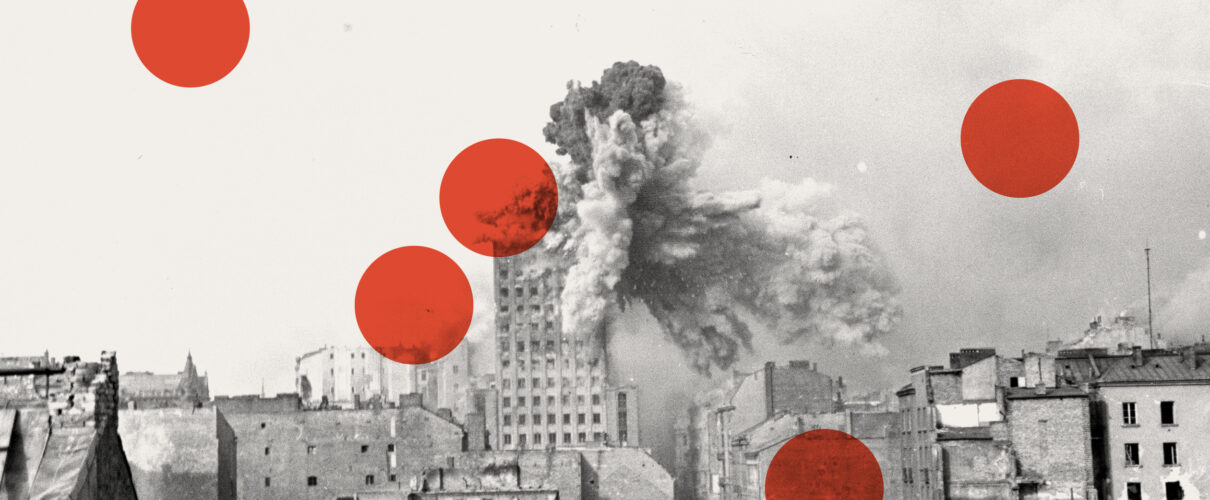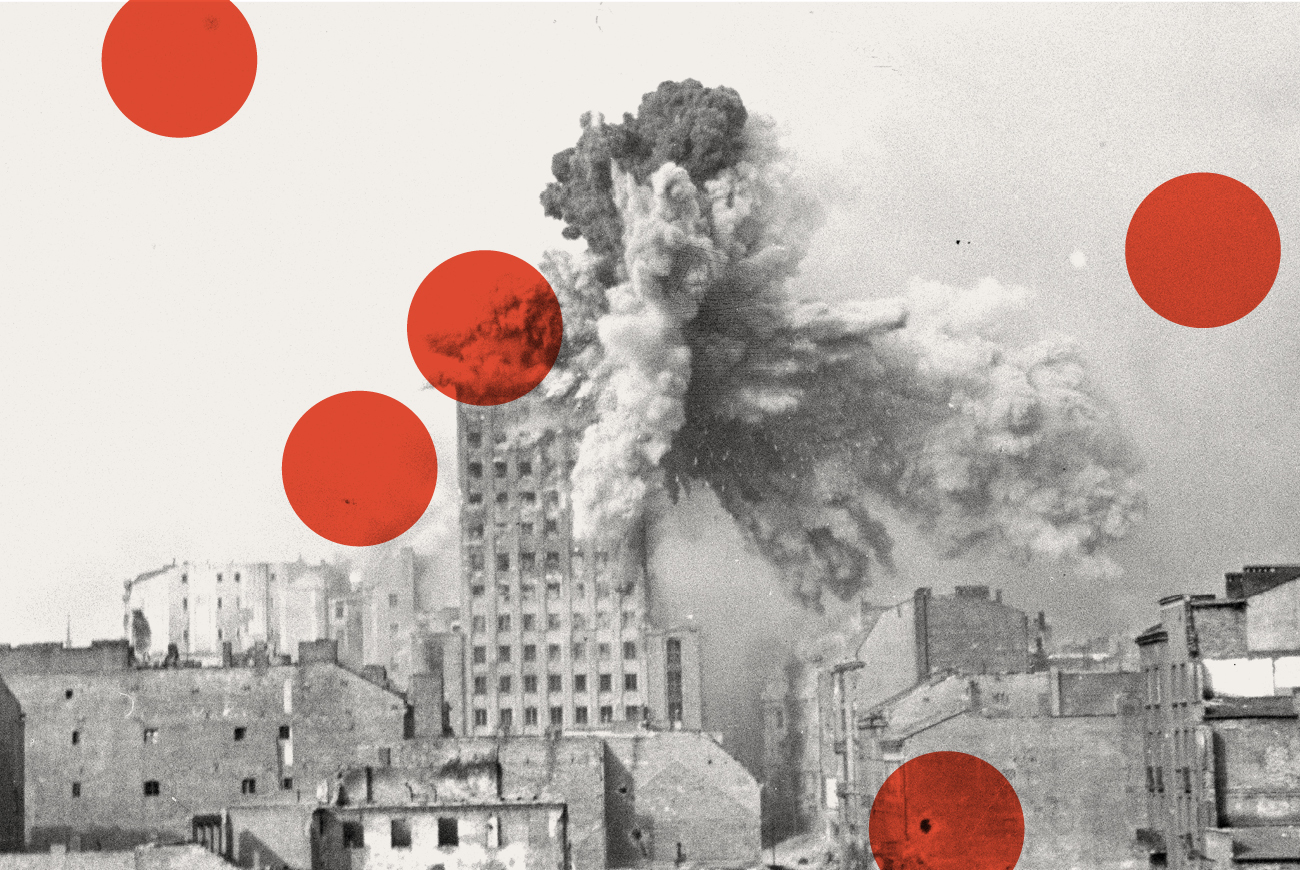EXHIBITIONS

30 July, 2024 - 30 March, 2025
25 PLN / 18 PLN, free admission on Thursdays
Sylwester “Kris” Braun. A Photographer of the Uprising

A unique exhibition and a book to commemorate the 80th anniversary of the Warsaw Uprising.
Photographs taken by Sylwester “Kris” Braun are amongst the most important documents from the Warsaw Uprising. In the exhibition Sylwester “Kris” Braun. A Photographer of the Uprising to open soon at the Museum of Warsaw, we present original prints developed by Braun himself. The exposition poses a question: when and how a biographical account turns into a historical narrative? It also introduces to the public Berta Weissberger, Braun’s assistant. On 30 July, we invite you to a book launch of an album under the same title, in which over 200 photos are accompanied by texts penned by Piotr Głogowski, Iwona Kurz, Tomasz Stempowski and Tomasz Szerszeń. The authors reveal fragments of Braun’s biography thus far unknown to the public and analyze his photographic techniques, the routes he followed as a photographer, as well as the iconography of the photos from the Uprising. The exhibition and the album are part of the commemorative program on the 80th anniversary of the Warsaw Uprising organized by the Museum of Warsaw.
Sylwester Braun aka ‘Kris’ is one of the most important photographers of the Warsaw Uprising.
Many of his photos taken in 1944 are now regarded as iconic. They are widely recognised and often referred to as the images of the Uprising, even if not identified by captions. Braun’s original prints are the most precious objects related to the Warsaw Uprising in the Museum of Warsaw’s photographic collection. Presenting them in the form of an exhibition and an album is our way to commemorate the 80th anniversary of the Uprising.
On 30 July at 6PM there will be a book launch of the album and opening of the exhibition, both titled Sylwester “Kris” Braun. A Photographer of the Uprising. During the meeting at the Museum of Warsaw’s Lapidarium at the Old Town Market Square, authors of the book will talk about the photographs and about the man who took them. The meeting will be chaired by Karolina Puchała-Rojek from the Museum of Warsaw’s Center of Photography. After the meeting, we will open the exhibition. It will be available for viewing as part of the Museum’s Core Exhibition until 29 December 2024.
The exhibition Sylwester “Kris” Braun. A Photographer of the Uprising offers a unique opportunity to see original prints made by Braun, to follow in the footsteps of the couple of photographers who traversed the city in the midst of the combat, and to check how a documentary record of events became a widely known narrative on the Warsaw Uprising.
The exhibition reflects the photojournalistic nature of Braun’s photographs, which is largely due to the fact that they form closed, well-studied series. The shots capture the daily life of the fighting city on a micro scale, showing its heroic moments—sometimes joyful, more often poignant and tragic. A checkpoint at a barricade, a piano concert, and well drilling are seemingly trivial themes that gain a profound significance when juxtaposed with other simultaneous events, such as the funeral of victims, a ride in a captured transporter, and the escorting of a column of prisoners.
Braun’s biography and, above all, the re-establishment of Berta Weissberger as an important protagonist in the story, demonstrates how many factors affect the creation and reception of historical narratives. During the Uprising, Braun had a pass that allowed him to move freely around the liberated areas of the capital city. He personally chose the subjects and scenes to photograph, and the prints he selected were distributed by the Home Army’s Bureau of Information and Propaganda. After the war, he made attempts to popularize his photographs, and when the political situation in the 1980s and 1990s allowed for the return of the Uprising iconography and for Braun’s own return to Poland, he actively participated in organizing exhibitions and book publications.
Thanks to many years of research carried out by the exhibition curator Piotr Głogowski, the locations captured in the photographs, the exact dates, and even the times of day when they had been taken have been identified, making it possible to reconstruct the routes Braun had followed and to reassemble the strips of negatives he had cut back into their original rolls.
The themes explored in the exhibition are further developed in the album under the title Sylwester “Kris” Braun. A Photographer of the Uprising. The fascinating life story and the rich body of work of one of the most important photographers of the 1944 Warsaw Uprising are described in the texts written by Piotr Głogowski, Iwona Kurz, Tomasz Stempowski and Tomasz Szerszeń. The publication follows in Braun’s footsteps through wartime Warsaw, analyzes his photographic techniques, and places his work in the context of other photographers of August and September 1944. Equally important is the legend Braun created about himself and the role his photographs play in the current narrative on the Warsaw Uprising. The album contains over two hundred of Braun’s photographs, primarily from 1944, as well as a selection of newspaper clippings and excerpts from correspondence. The book is published in a bilingual Polish-English edition.
Sylwester “Kris” Braun (1909–1996) was active in the resistance as a member of the Union of Armed Struggle and later the Home Army. During the Warsaw Uprising, dressed in civilian clothes and equipped with a small Leica Standard camera tucked in his jacket pocket, he roamed the streets of Śródmieście, central Wola, and Powiśle quarters. He paid close attention to the composition of his shots, often taking various perspectives by climbing onto roofs or standing right behind the defenders of barricades. He frequently repeated shots, making slight adjustments. Braun captured the ruins and ongoing combat as well as moments of respite, such as a piano concert at the ‘U Aktorek’ café.
Although most of the photos and negatives were destroyed in a fire in the photographer’s apartment in Powiśle, some of the films were hidden in jars in the basement of a building on Marszałkowska Street and recovered after the war ended. With time, the photos from the Uprising became increasingly recognizable but their author, who had been living abroad for many years, remained largely unknown. It was not until 1979, thanks to an initiative by Kurier Polski, that Sylwester Braun’s life and work were popularized. In 1981, the photographer donated a collection of over 1,500 surviving negatives to the Museum of Warsaw.
Subsidized by the Ministry of Culture and National Heritage from the Culture Promotion Fund—a state earmarked fund and the Ministry of Culture and National Heritage.
curator Piotr Głogowski
cooperation Karolina Puchała-Rojek
exhibition design Studio ŚŃŃ Maciej Chodziński, Katarzyna Łygońska, Tomasz Świetlik
production Katarzyna Jolanta Górska
graphic design of the poster and promotional materials Anna Światłowska
editor Urszula Drabińska
translator Aleksandra Szymczyk
technical setup and implementation Ksenia Góreczna, Paweł Grochowalski, Krzysztof Hernik, Katarzyna Radecka, Adam Rogowski, Leszek Sokołowski
multimedia Anna Mizikowska
conservation Julia Kłosińska, Piotr Popławski
digitization coordinator Mikołaj Kalina
digitization Adrian Czechowski, Eliza Kowalska-Małek, Kamil Łuczak, Michał Matyjaszewski, Anna Sulej
in-house loans Tomasz Lewandowski, Dorota Parszewska, Zuzanna Sieroszewska-Rolewicz
legal services Monika Góra
communications and marketing Joanna Andruszko, Małgorzata Czajkowska, Melissa Czaplicka, Karina Dąbska, Agata Fijałkowska, Agata Fronczyk, Klaudia Gniady, Dagmara Jędrzejewska, Daniel Karwowski, Anna Ładna, Aleksandra Migacz, Jowita Purzycka, Dorian Widawski


